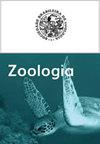Genetic analysis of whole mitochondrial genome of Lateolabrax maculatus (Perciformes: Moronidae) indicates the presence of two populations along the Chinese coast
IF 1.8
4区 生物学
Q4 ZOOLOGY
引用次数: 1
Abstract
The whole mitochondrial genome of Lateolabrax maculatus (Cuvier, 1828) was used to investigate the reasons for the observed patterns of genetic differentiation among 12 populations in northern and southern China. The haplotype diversity and nucleotide diversity of L. maculatus were 0.998 and 0.00169, respectively. Pairwise FST values between populations ranged from 0.001 to 0.429, correlating positively with geographic distance. Genetic structure analysis and haplotype network analysis indicated that these populations were split into two groups, in agreement with geographic segregation and environment. Tajima’s D values, Fu’s Fs tests and Bayesian skyline plot (BSP) indicated that a demographic expansion event may have occurred in the history of L. maculatus. Through selection pressure analysis, we found evidence of significant negative selection at the ATP6, ND3, Cytb, COX3, COX2 and COX1 genes. In our hypotheses, this study implied that demographic events and selection of local environmental conditions, including temperature, are responsible for population divergence. These findings are a step forward toward the understanding of the genetic basis of differentiation and adaptation, as well as conservation of L. maculatus.对黄斑鱼尾形目线粒体全基因组的遗传分析表明,黄斑鱼在中国沿海地区存在两个种群
利用Lateolabrax maculatus (Cuvier, 1828)的线粒体全基因组,研究了中国北方和南方12个居群遗传分化模式的原因。单倍型多样性为0.998,核苷酸多样性为0.00169。种群间FST的两两变化范围为0.001 ~ 0.429,与地理距离呈正相关。遗传结构分析和单倍型网络分析表明,这些居群分为两个居群,与地理分离和环境条件一致。Tajima的D值、Fu的f值检验和贝叶斯天际线图(BSP)表明,黄斑L.在历史上可能发生过人口扩张事件。通过选择压力分析,我们发现ATP6、ND3、Cytb、COX3、COX2和COX1基因存在显著的负选择。在我们的假设中,本研究暗示人口事件和当地环境条件(包括温度)的选择是导致人口分化的原因。这些发现为进一步了解黄斑乳杆菌的分化、适应和保护的遗传基础迈出了一步。
本文章由计算机程序翻译,如有差异,请以英文原文为准。
求助全文
约1分钟内获得全文
求助全文
来源期刊

Zoologia
生物-动物学
自引率
0.00%
发文量
15
期刊介绍:
Zoologia, the scientific journal of the Sociedade Brasileira de Zoologia (SBZ), is an international peer-reviewed, open-access Zoological journal that publishes original research on systematics, evolution, taxonomy, nomenclature, biogeography, morphology, physiology, biology, ecology, symbiosis, conservation, behavior, genetics and allied fields. The journal, formerly known as Revista Brasileira de Zoologia, publishes original articles authored by both members and non-members of the Society. The manuscripts should be written exclusively in English.
 求助内容:
求助内容: 应助结果提醒方式:
应助结果提醒方式:


